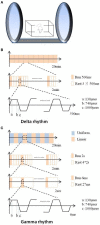Low Field Magnetic Stimulation Ameliorates Schizophrenia-Like Behavior and Up-Regulates Neuregulin-1 Expression in a Mouse Model of Cuprizone-Induced Demyelination
- PMID: 30574102
- PMCID: PMC6291499
- DOI: 10.3389/fpsyt.2018.00675
Low Field Magnetic Stimulation Ameliorates Schizophrenia-Like Behavior and Up-Regulates Neuregulin-1 Expression in a Mouse Model of Cuprizone-Induced Demyelination
Abstract
White matter and myelin sheath integrity are disrupted in schizophrenia, and non-invasive magnetic brain stimulation targeting these tracts is a promising new therapeutic approach. In particular, deep-brain reachable low field magnetic stimulation (DMS) could alleviate cognitive impairment and depressive-like behaviors in animal models. In this study, we sought to assess the effects of DMS on myelin sheath damage and schizophrenia-like behaviors in the cuprizone-induced demyelination mouse model. Mice were fed cuprizone (copper ion chelating agent, 0.2% w/w mixed with food) for 6 weeks to induce demyelination. During these 6 weeks, mice were stimulated with either sham, low-frequency (LFS, delta frequency) DMS or high-frequency (HFS, gamma Hz) DMS for 20 min each day. Behavioral tests were conducted 24 h after the final DMS session. The myelin sheath was examined by immunohistochemistry and the expression of neuregulin-1 (NRG1)/ErbB4 in the prefrontal cortex was measured with Western blotting. Six weeks of HFS significantly alleviated schizophrenia-like behaviors in cuprizone mice, including improved nesting, social interaction and sensorimotor gating, while LFS improved sensorimotor gating only. HFS and LFS both repaired the myelin sheath and increased the expression of neuregulin-1 and its receptor ErbB4, in the prefrontal cortex of demyelinated mice. Our findings show that DMS is a potential effective neuromodulation technique for the treatment of schizophrenia. One possible mechanism underlying these therapeutic effects could involve the up-regulation of NRG1/ErbB4 signaling in the prefrontal cortex.
Keywords: low field magnetic stimulation; myelin sheaths; neuregulin-1; neuromodulation; schizophrenia.
Figures






Similar articles
-
Shi-Zhen-An-Shen Decoction, a Herbal Medicine That Reverses Cuprizone-Induced Demyelination and Behavioral Deficits in Mice Independent of the Neuregulin-1 Pathway.Neural Plast. 2021 Feb 25;2021:8812362. doi: 10.1155/2021/8812362. eCollection 2021. Neural Plast. 2021. PMID: 33708250 Free PMC article.
-
Clemastine rescues behavioral changes and enhances remyelination in the cuprizone mouse model of demyelination.Neurosci Bull. 2015 Oct;31(5):617-25. doi: 10.1007/s12264-015-1555-3. Epub 2015 Aug 6. Neurosci Bull. 2015. PMID: 26253956 Free PMC article.
-
Quetiapine enhances oligodendrocyte regeneration and myelin repair after cuprizone-induced demyelination.Schizophr Res. 2012 Jun;138(1):8-17. doi: 10.1016/j.schres.2012.04.006. Epub 2012 May 1. Schizophr Res. 2012. PMID: 22555017
-
Quetiapine Ameliorates Schizophrenia-Like Behaviors and Protects Myelin Integrity in Cuprizone Intoxicated Mice: The Involvement of Notch Signaling Pathway.Int J Neuropsychopharmacol. 2015 Aug 1;19(2):pyv088. doi: 10.1093/ijnp/pyv088. Int J Neuropsychopharmacol. 2015. PMID: 26232790 Free PMC article.
-
BACE1-Dependent Neuregulin-1 Signaling: An Implication for Schizophrenia.Front Mol Neurosci. 2017 Sep 25;10:302. doi: 10.3389/fnmol.2017.00302. eCollection 2017. Front Mol Neurosci. 2017. PMID: 28993723 Free PMC article. Review.
Cited by
-
Shi-Zhen-An-Shen Decoction, a Herbal Medicine That Reverses Cuprizone-Induced Demyelination and Behavioral Deficits in Mice Independent of the Neuregulin-1 Pathway.Neural Plast. 2021 Feb 25;2021:8812362. doi: 10.1155/2021/8812362. eCollection 2021. Neural Plast. 2021. PMID: 33708250 Free PMC article.
-
Audiovisual gamma stimulation for the treatment of neurodegeneration.J Intern Med. 2024 Feb;295(2):146-170. doi: 10.1111/joim.13755. Epub 2023 Dec 19. J Intern Med. 2024. PMID: 38115692 Free PMC article. Review.
-
Maternal immune activation induces sex-dependent behavioral differences in a rat model of schizophrenia.Front Psychiatry. 2024 Apr 10;15:1375999. doi: 10.3389/fpsyt.2024.1375999. eCollection 2024. Front Psychiatry. 2024. PMID: 38659461 Free PMC article.
-
A systematic review and meta-analysis of the preclinical and clinical results of low-field magnetic stimulation in cognitive disorders.Rev Neurosci. 2024 Apr 29;35(6):619-625. doi: 10.1515/revneuro-2024-0023. Print 2024 Aug 27. Rev Neurosci. 2024. PMID: 38671560 Free PMC article.
-
Deep rTMS Mitigates Behavioral and Neuropathologic Anomalies in Cuprizone-Exposed Mice Through Reducing Microglial Proinflammatory Cytokines.Front Integr Neurosci. 2020 Nov 5;14:556839. doi: 10.3389/fnint.2020.556839. eCollection 2020. Front Integr Neurosci. 2020. PMID: 33250722 Free PMC article.
References
-
- Andreasen NC. Symptoms, signs, and diagnosis of schizophrenia. Lancet (1995) 346:477–81. - PubMed
LinkOut - more resources
Full Text Sources

